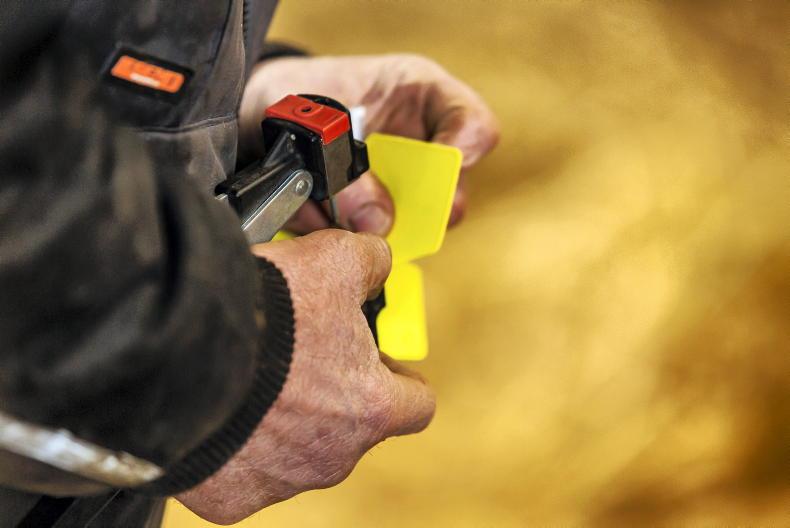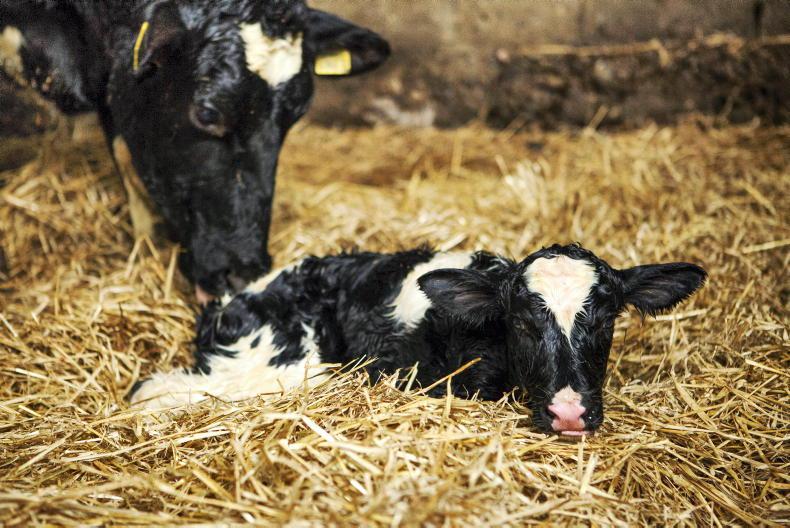There is only a month left before new rules concerning electronic identification in cattle come in to play. From 1 January 2022, all tag sets provided by tag suppliers for the registration of calves must possess an electronic tag. This ruling is in advance of mandatory bovine electronic identification being introduced for all newborn calves from 1 July 2022.
The electronic tag will be white in colour to differentiate it from the remaining three yellow tags. This is in contrast to existing EID tags which will continue to be yellow in colour. The corresponding ear tag will continue to be a tissue tag for collecting samples under the Bovine Viral Diarrhoea National Eradication Programme.
As detailed in Table 1, the cost of electronic identification (EID) tag sets will range from €3.95 to €4.09 per set, or an increase of €1.05 to €1.11 over the existing tissue tag set. Based on 2.38m calves registered in 2020, the move to EID tagging will cost farmers in the region of an additional €2.5m per annum to register their calves.
Tag subsidy scheme
Minister for Agriculture Charlie McConalogue announced in early November that he had secured a budget of €4.25m to introduce a tag subvention, or subsidy, scheme.
This scheme will operate over three years from 2022 to 2024, and it is expected that funding will be front loaded with a predicted allocation of €2.25m in year one.
The starting date of the scheme coincides with tag suppliers being obliged to only offer EID tag sets from 1 January. Payments will be calculated on the number of new EID tag sets purchased from 1 January 2022 at a rate of €1 per set.
Payment is capped at €100 per farmer over the three years of the scheme, meaning farmers can receive a subsidy on a maximum of 100 tags.
No application process is required and payments will take place in a tranche system, with the first payment expected to take place in quarter four of 2022.
The maximum level of payment a farmer can receive in any one year is influenced by the number of breeding females in the herd and is already governed by the tag threshold system introduced on 22 July 2022 to comply with EU legislation.
The threshold is based on the average number of calves born in the previous three years, plus an allowance to take account of a possible small increase in numbers.
The tag threshold can be easily accessed through the Department of Agriculture agfood facility while some tag companies also have a link to this facility on their website. Farmers who wish to increase their threshold on the back of an increase in births in the coming season can notify the Department to do so.
In their initial announcement, the Department outlined two payment examples are as follows;
A farmer who purchases 30 new EID tag sets each year will be eligible for a payment of €30 in each year of the proposed three years of the scheme. The maximum payment achieved in such a herd will be €90.A farmer who purchases 100 new EID tags in year one will be eligible for a payment of €100 in year one, however, they will not be eligible for further payments in years two or three of the scheme. Minister Charlie McConalogue has also stated that the scheme is proportionately weighted in favour of smaller producers, with the three-year lifetime of the programme giving a greater chance for these producers to draw down funding to cover three year’s worth of calf registrations.
The Irish Farmers Journal understands that the reasoning behind this system is that it is believed that dairy farmers with larger herds will be in a better position to integrate electronic identification into everyday herd management.
Ordering conventional tags
Farmers can continue to order conventional tags up until 31 December 2021, but it is important that you only order the number of tags that will be used by 20 June 2022, as any existing supplies of conventional tags will no longer be permitted to be used after 1 July 2022.
Farm organisations state that they will continue dialogue with the Department with a view to increasing the level of subvention available to farmers.
From 1 January 2022, tag suppliers will only be able to supply new tag sets for registering calves with an electronic tag.All calves born from 1 July 2022 must be tagged with a tag set possessing an electronic tag. All existing tags must be used by 30 June 2022, as after this date, existing tags will be null and void.
There is only a month left before new rules concerning electronic identification in cattle come in to play. From 1 January 2022, all tag sets provided by tag suppliers for the registration of calves must possess an electronic tag. This ruling is in advance of mandatory bovine electronic identification being introduced for all newborn calves from 1 July 2022.
The electronic tag will be white in colour to differentiate it from the remaining three yellow tags. This is in contrast to existing EID tags which will continue to be yellow in colour. The corresponding ear tag will continue to be a tissue tag for collecting samples under the Bovine Viral Diarrhoea National Eradication Programme.
As detailed in Table 1, the cost of electronic identification (EID) tag sets will range from €3.95 to €4.09 per set, or an increase of €1.05 to €1.11 over the existing tissue tag set. Based on 2.38m calves registered in 2020, the move to EID tagging will cost farmers in the region of an additional €2.5m per annum to register their calves.
Tag subsidy scheme
Minister for Agriculture Charlie McConalogue announced in early November that he had secured a budget of €4.25m to introduce a tag subvention, or subsidy, scheme.
This scheme will operate over three years from 2022 to 2024, and it is expected that funding will be front loaded with a predicted allocation of €2.25m in year one.
The starting date of the scheme coincides with tag suppliers being obliged to only offer EID tag sets from 1 January. Payments will be calculated on the number of new EID tag sets purchased from 1 January 2022 at a rate of €1 per set.
Payment is capped at €100 per farmer over the three years of the scheme, meaning farmers can receive a subsidy on a maximum of 100 tags.
No application process is required and payments will take place in a tranche system, with the first payment expected to take place in quarter four of 2022.
The maximum level of payment a farmer can receive in any one year is influenced by the number of breeding females in the herd and is already governed by the tag threshold system introduced on 22 July 2022 to comply with EU legislation.
The threshold is based on the average number of calves born in the previous three years, plus an allowance to take account of a possible small increase in numbers.
The tag threshold can be easily accessed through the Department of Agriculture agfood facility while some tag companies also have a link to this facility on their website. Farmers who wish to increase their threshold on the back of an increase in births in the coming season can notify the Department to do so.
In their initial announcement, the Department outlined two payment examples are as follows;
A farmer who purchases 30 new EID tag sets each year will be eligible for a payment of €30 in each year of the proposed three years of the scheme. The maximum payment achieved in such a herd will be €90.A farmer who purchases 100 new EID tags in year one will be eligible for a payment of €100 in year one, however, they will not be eligible for further payments in years two or three of the scheme. Minister Charlie McConalogue has also stated that the scheme is proportionately weighted in favour of smaller producers, with the three-year lifetime of the programme giving a greater chance for these producers to draw down funding to cover three year’s worth of calf registrations.
The Irish Farmers Journal understands that the reasoning behind this system is that it is believed that dairy farmers with larger herds will be in a better position to integrate electronic identification into everyday herd management.
Ordering conventional tags
Farmers can continue to order conventional tags up until 31 December 2021, but it is important that you only order the number of tags that will be used by 20 June 2022, as any existing supplies of conventional tags will no longer be permitted to be used after 1 July 2022.
Farm organisations state that they will continue dialogue with the Department with a view to increasing the level of subvention available to farmers.
From 1 January 2022, tag suppliers will only be able to supply new tag sets for registering calves with an electronic tag.All calves born from 1 July 2022 must be tagged with a tag set possessing an electronic tag. All existing tags must be used by 30 June 2022, as after this date, existing tags will be null and void. 









SHARING OPTIONS